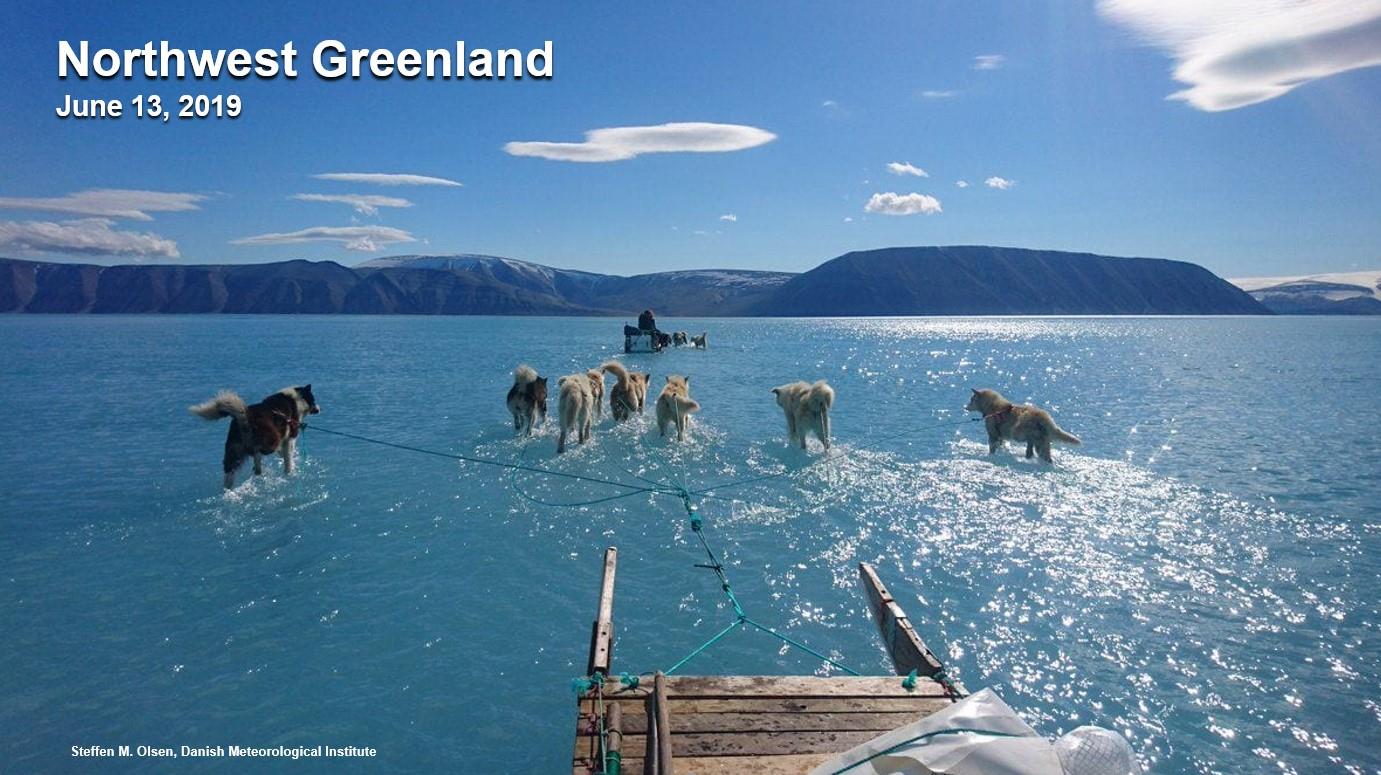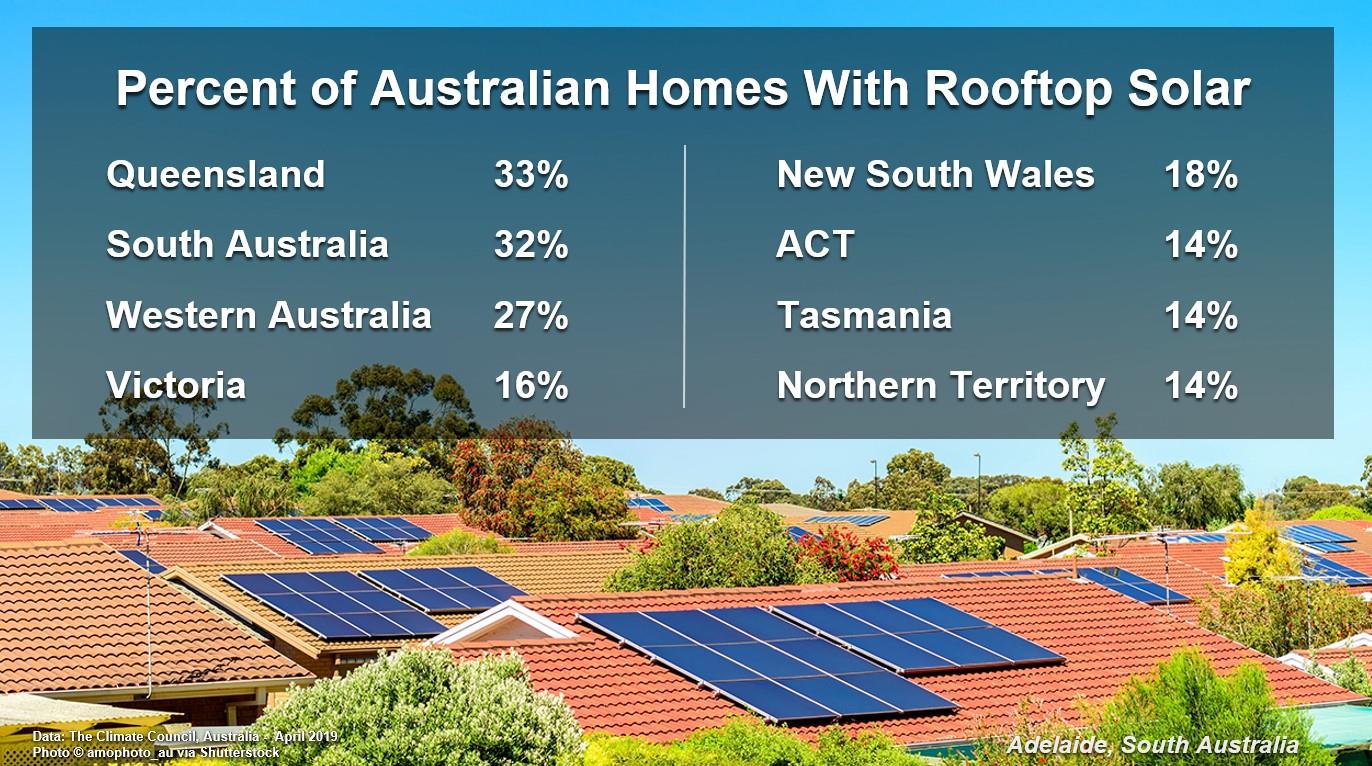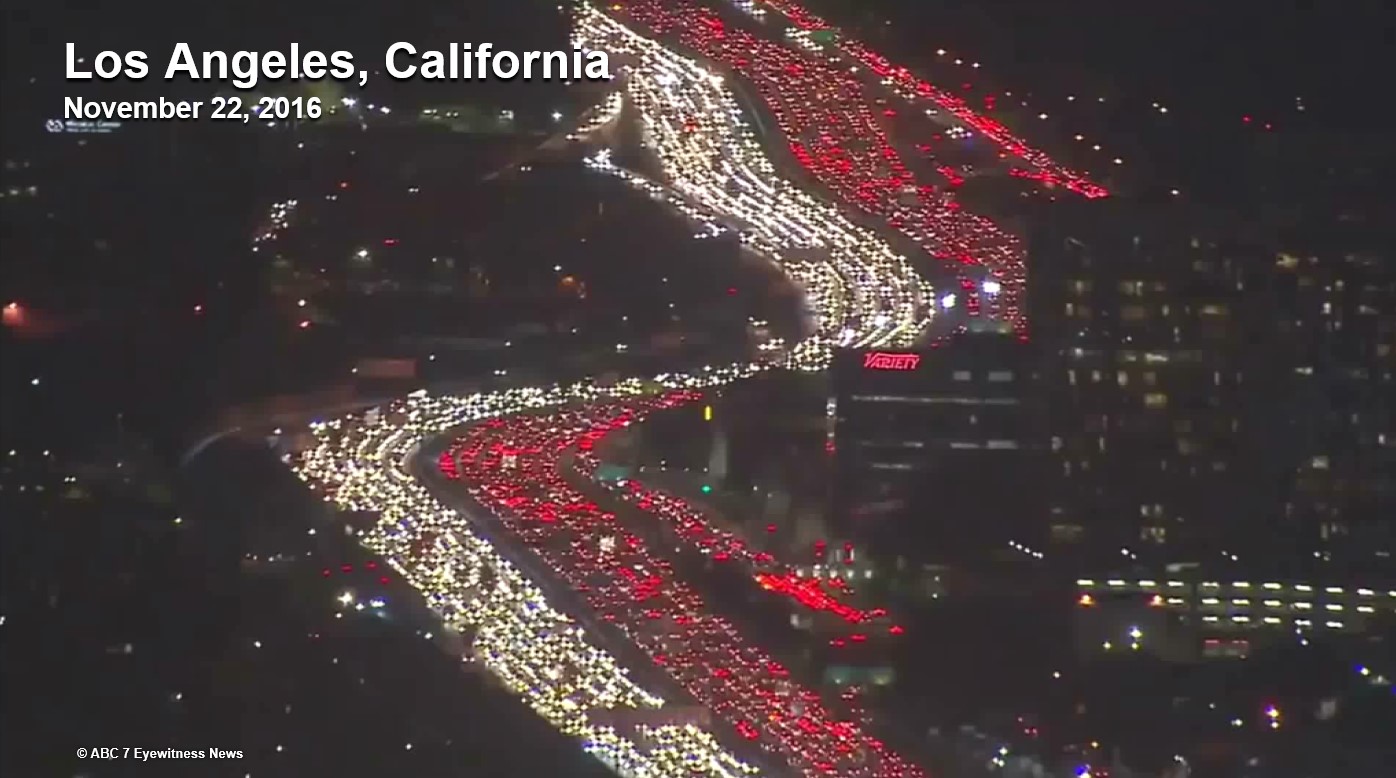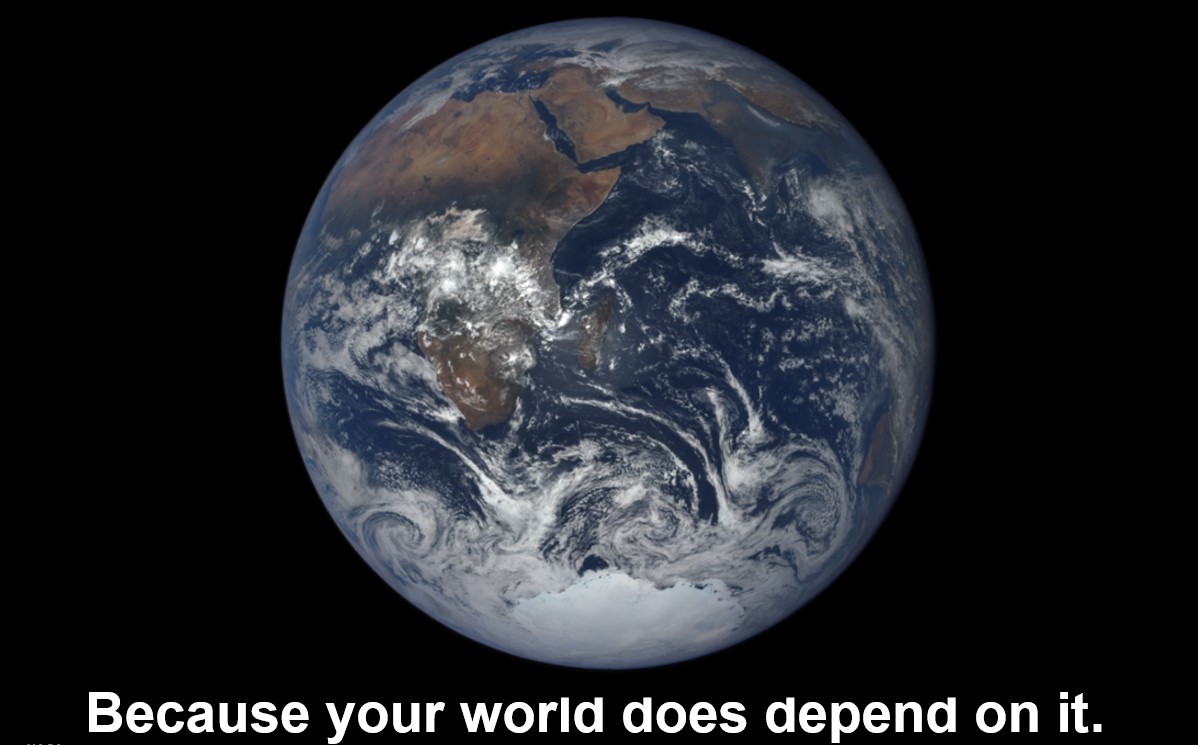The “Earthrise” photo was taken by Apollo 8 astronaut Bill Anders on December 24, 1968, in orbit around the Moon. It was the first image of the Earth as it appeared from deep space, and demonstrates the fragility, size, and finite nature of the planet.

Photo of Earth taken over the lunar horizon from the Apollo 8 command module, December 24, 1968

And here is how it works: the natural layer of greenhouse gases is important because when the sun’s energy comes into the Earth in the form of light, that energy warms up the planet and some of it escapes by way of infrared radiation. But some is trapped and that’s the natural greenhouse gas effect and that’s a good thing because it keeps the temperatures here on Earth in an ideal range that is suitable and really perfect for the lifeforms that have been created and have evolved here, including us. The basic problem is, we are now thickening this layer of greenhouse gases.
We are currently emitting 110 million tons of man-made pollution into the thin shell of our atmosphere every 24 hrs. Of course, that means the natural greenhouse gas layer gets thicker and more of the outgoing infrared (radiation) is trapped and so temperatures go up. That’s a basic problem, but a lot flows from that.
John mentioned that discoveries of this happening have already been published over 100 years ago.
The CO2 that nature emits (from the ocean and vegetation) is balanced by natural absorptions (again by the ocean and vegetation). Therefore human emissions upset the natural balance, rising CO2 to levels not seen in at least 800,000 years. In fact, human emit 26 gigatonnes of CO2 per year while CO2 in the atmosphere is rising by only 15 gigatonnes per year - much of human CO2 emissions is being absorbed by natural sinks. But the main source by far, is the burning of fossil fuels. We still depend on coal, oil, and gas for 80 percent of all the energy the world economy needs. You can see from this graph, that after World War II, it started rising dramatically. The CO2 emissions began to really get outside of all historic boundaries. It has become quite an issue because CO2 is being released faster than at any time since the asteroid hit Yucatan and wiped out the dinosaurs 66 million years ago.
The problem is that now we have seen with all of this man-made global warming pollution, the increase in CO2 has taken the concentrations up to 415 (parts per million (ppm)). It never got above 280 or 300 ppm at most during the previous 800,000 years. So, if this much of a difference on the cold side is a kilometer of ice over your head, how much difference would this be on the warm side? Well, the scientists have been working real hard to tell us the answer. The answer is we can’t let this happen. It’s already serious. But here is where the scientists tell us it’s going in the next 40 years if we don’t make changes. This is what we cannot let happen under any circumstances. This would threaten the end of human civilization as we know it. And I will give you some of the reasons why from the scientists.
This past year we’ve seen temperature records broken one right after another. 46 degrees in Paris. They broke their all-time high temperature record by four full degrees. Not by a tenth of a degree or two tenths of a degree. Japan, which normally doesn’t get such high temperatures, has been breaking its all-time records above 39 degrees Celsius. Also Australia recorded several records during the 'Angriest Summer' of 2018-19.
But at the North Pole itself, one sees the Arctic Ice melting so rapidly it will soon be completely gone in summertime.

this is an example. I went back up to Greenland just a few years ago during one of these heatwaves. Map of the Arctic region, centered on Greenland, with temperature anomalies overlaid for April 11, 2016.
The area has heated up so much that instead of ice the sled dogs are pulling the sled over slushy water.
If this continues the top ten cities that are at risk from sea level rise measuring the population are mostly in Asia. Cities like Kolkata, Mumbai, Dhaka, Guangzhou, Ho Chi Minh City, Shanghai, Bangkok, Rangoon, Miami, Hai Phong; but measuring the risk based on assets cities like Miami, Guangzhou, New York, Kolkata, Shanghai, Mumbai, Tianjin, Tokyo, Hong Kong and Bankok are mostly at risk.

One of the other consequences of warming up the ocean so much, and the air, is that it disrupts the water cycle. The evaporation of water vapor off the oceans increases dramatically. The warmer air holds more water. So when it comes over land…we get these tremendous downpours. The scientists are calling them rain bombs now. And much more of the rainfall, and snowfall in winter, comes in these one-time storm events, that causes more floods.
Now, to shift gears a little bit. The same extra heat that disrupts the water cycle and increases the water vapor from the ocean also pulls the moisture out of the soil, and makes the droughts hit quicker and go deeper and last longer.
New South Wales in Australia, the worst drought people there can remember, going into the second year now.
The Forest Fire Danger Index—an indicator of the severity of fire weather conditions. Positive trends, shown in the yellow to red colours, are indicative of an increasing length and intensity of the fire weather season.
In November 2018, we saw the Paradise fire in California, 14,000 homes and businesses destroyed, 86 people killed.
Through 2019 and into 2020, an early start to the NSW/QLD/Victoria bushfire season, with hundreds of fires in SE Australia, burning more that 18 million hectares, 2,200 homes destroyed, and 29 lives lost to date. Greg Mullins, the former chief of NSW Fire and Rescue stated in November 2019:"Just a 1C temperature rise has meant the extremes are far more extreme, and it is placing lives at risk, including firefighters. Climate change has supercharged the bushfire problem.”
But this is a global phenomenon. Sweden has had an increase of fires, including eight last year above the Arctic Circle. Greenland has experienced major fire threat as well.
On the other hand the 2006-2010 drought and drying trend turned 60% of Syria's fertile land into desert and drove 1.5 million people into Syria's already crowded cities, precipitating civil war and migration into Europe. The world could see up to 1 billion climate migrants!
And actually, all of us have cause for deep concern about the impact of the climate crisis on the world’s food supply generally. I am not going to go through all of these linkages, but the Intergovernmental Panel on Climate Change just put out a masterful, comprehensive report on this, just recently. The scientists are now projecting yield declines for each additional one degree that are significant: 7.4 percent for maize, or corn as the US calls it; 6 percent for wheat; 3.2 percent for rice; 3.1 percent for soy, for each one-degree increase. And these four crops make up two-thirds of all the calories that humanity absorbs every day and every year.
How does it affect health?
the people most vulnerable to heat are the poor and homeless, the elderly, infants and children, those with pre-existing medical conditions, particularly cardiac and respiratory conditions, the mentally ill and agricultural workers and those with outdoor jobs.
When the world gets warmer and the moisture patterns are more chaotic, then that’s better for the diseases and worse for human beings. We’re now seeing the spread of tropical diseases all around the world. Some of this is due to air travel for sure, but the way the climate crisis changes the conditions, that changes where these diseases take root and become endemic threats to the people who live there. And that’s what’s happening with climate and infectious diseases. Half of all the land-based species are at risk of extinction in this century! On our watch! That, again, cannot be deemed acceptable. These consequences of the climate crisis are mounting up.
If you try to put a cost on them and add them up, it’s just unbelievable. We haven’t even talked about the acidification of the ocean, the infrastructure loss, some of these other consequences. I will mention one more: it’s the number one threat to the global economy as the World Economic Forum has warned us for each of the last four years. This is a financial crisis as well. The governor of the Bank of England points out that we have so many carbon reserves that are on the books of these multinational companies and sovereign wealth of funds in the oil producing areas. And most of those carbon reserves are unburnable.
But governments are still subsidizing the burning of fossil fuels at a rate much larger than the subsidies for renewables. This is an insane policy and it reflects the continuing political and economic power of the fossil fuel companies. They’ve been building it up for quite a while. So, they get 36 times the subsidies that the renewables we need to switch to are getting.
Must we change? Clearly, yes, we have to change. What we’re doing is destroying the conditions that foster the thriving of human civilization, humanity, and the life forms with which we share this Earth.
What about the second question, “Can we change?” Well, here is where the good news starts.
Globally, wind could supply worldwide electricity consumption 40 times over. In England, the birthplace of the coal revolution so long ago, they now get three times as much electricity from wind as they do from burning coal.
Two-thirds of all the people in the world now live in regions where the cheapest forms of electricity are solar and wind. And since the cost of solar and wind electricity continues to go down significantly year after year, month after month, we will soon be at nearly 100 percent of all the people in the world being able to turn to renewables as the cheapest form of electricity. On a global basis, we get more energy from the sun in one hour than the entire global economy uses in an entire year. So, if we just steadily increase the fraction of that energy that we can harvest economically, then we can replace fossil fuels sooner than many people have expected.

Storage of electricity makes it possible to use solar energy even after the sun has gone down, to use wind energy after the wind has stopped blowing for the day or night, and you can see the growth in this capacity. I’m going to rescale this graph to show what the projections are in the years ahead. The Lithium-ion Battery prices continue to go down. That’s one of the reasons why this change is so dramatic. The largest battery in the world was installed by Tesla in South Australia. It’s working magnificently, but it won’t be the biggest for long.
That brings us to transportation. Electricity generation, we’re seeing the incredible promise of solar and wind growing, but actually in the US and some other countries, the largest source of CO2 emissions is now from transportation. This is Los Angeles at Thanksgiving.
But there is hope here as well. We’re seeing electric cars really come on like gangbusters. The popularity of these vehicles is, in part, due to the fact that they’re fun to drive and those who have one will tell you that, I have one. The cost is now coming down quite quickly. The powertrain, which is the most expensive part of these vehicles, is going to be cheaper in an electric vehicle than in an internal combustion engine vehicle by next year or the year after, maybe two years from now. The largest vehicle manufacturer in the US, General Motors is on board. Tesla, of course, has been helping to drive this revolution.
In the United States, for the last five years, solar jobs have been the fastest growing category, growing six times faster than average job growth. The second fastest growing job is wind turbine technician. This is the part of the economy where the millions of new jobs are coming from. This is where we can get sustainable economic growth for the future and put so many people to work. There are now five times as many jobs in the US in solar as in coal mining.
So, the answer to the second question, “Can we change?” is “Yes!” We’ve got what we need, it’s getting better all the time, we just need policy and we need to drive these changes more quickly.
In the Paris Agreement, almost five years ago, we saw all 195 countries in the entire world agree to go to net zero emissions by mid-century, just 30 years from now. This coming year is when all of these countries have made a commitment to reconvene and examine how the newly cheaper sources of renewable energy, electric vehicles, efficiency improvements, will allow them to make even bolder pledges to reduce their emissions by even more. Of course, President Trump in the US announced that he wants to take the US out of the Paris Agreement, but here’s something very important to remember: under international law, the first day the US could actually legally withdraw from the Paris Agreement is the day after the next presidential election in the US, next year. So, the American people will still control this decision. What happens in that election will have an outsized importance for the climate prospects.
In the meantime, we’re seeing, as market analysts keep reminding us, that the dramatic and continuing cost reductions for renewable energy, electric vehicles, batteries, efficiency improvements, that’s really what’s driving this. It’s going to continue to drive this change regardless of who occupies the White House.
30 countries have joined the Powering Past Coal alliance, a group dedicated to “taking action to accelerate clean growth and climate protection through the rapid phase-out of traditional coal power.” Some of the biggest investors in the world, like the largest sovereign wealth fund in Norway has started divesting from oil and gas investments. 112 global financial institutions have announced they will stop financing coal-fired power plants. Over 190 global companies have made a commitment to go 100% renewable.
More good news. China and India, the number one and the number four largest producers of greenhouse gas pollution, are both on track to way overachieve the commitments they made in Paris. They’re still burning a lot of fossil fuels and we need to do more, but this is progress, and more is in the pipeline.
Please join those who are using their voices, and their votes, and their choices in life to fight the climate crisis. Become a part of this movement to speak truth to power. Do it like your world depends on it…
